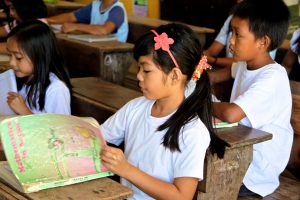When the Philippines reopens schools on October 5, it won’t rely on Zoom classes, nor will it gamble with socially distanced classrooms. Instead, it’s planning to print out millions of paper packets – even though it’s having trouble paying for them.
Around 60 percent of Filipino students are receiving “learning modules” that the country’s education department is rushing to deliver before school starts next week. The modules, which are packed with lessons and assignments to be picked up by teachers at specific drop-off points, are the department’s solution to the lack of access millions of Filipinos have to technology and internet connectivity.
As of September 28, one week before the beginning of classes, around 20 percent of the modules had yet to be delivered, although the education department insisted it was not running behind schedule.
The Philippines had previously planned to open schools on August 24, but this date was pushed back despite an earlier insistence that the country would be ready to adopt distance learning methods by that date. At the time, the government said the date was moved to allow enough time to print modules.
Now, ahead of the October 5 start date, the education department is facing similar calls to postpone classes until 2021 as the coronavirus pandemic continues unabated in the Philippines.
Education Secretary Leonor Briones said on September 29 that another postponement was not an option, adding that President Rodrigo Duterte had personally chosen the new start date. “In Southeast Asia, other countries have already opened schools. We’re the last one to open in October,” she said.
Some teachers and parents, however, are wary about the plans to push forward with the current opening date. Teachers will have to retrieve assignments from students at designated pickup points, raising fears they could contract the coronavirus.
There are also fears that parents will be unable to assist their children due to their own work obligations and, in some cases, their inability to read or write themselves.
“There are parents who are ‘no-read, no-write,’” one public school teacher told Rappler in May. “They are sending their children to school because they don’t want their children to be like them.”
The module program itself may have a short shelf life due to a lack of funds in the Department of Education, Briones said in September. Teachers have had to rely on donations for paper and printers to print enough modules for their students after using up their allocated funds.
Some groups have worried that Duterte’s 2021 budget has not considered the education department’s new needs, especially as it aims to provide more students access to digital learning rather than the modular method. Local governments have already raised money to provide children with learning technology.
Ralph Recto, a senator and economist, has said that, for one full academic year, the education department would have to print 93.6 billion pages of learning modules to be distributed among 21 million students. The department will not have the money to complete this task even on a conservative estimate, Recto warned.
Briones has said a lack of digital learning could render Filipinos less competitive compared to their regional counterparts, who have transitioned to mostly online classes. Within the Philippines, however, the new learning techniques are only exacerbating an education gap between the country’s richest and its poorest.
The education department said Monday it would hire aides to assist teachers in facilitating modular learning.
As of Monday, around 24.6 million students in public and private schools had registered for classes beginning on October 5, around three million less than the 27.7 million students who registered last year.
































